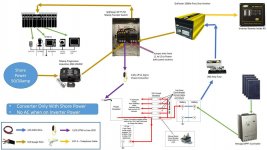I think I have found a solution to installing the inverter. Today I talked to the dealer that sold me the inverter about how I can use a inverter to make both legs of 120 volts hot. It will involve reducing the amperage of the entire 5th wheel to 30 amps, which I think is a good tradeoff for the type of camping that we do.
The plan is to unhook one leg of the incoming power and cap it. Then tie both legs together in the breaker box. That way when the trailer is plugged into a 50 amp pedestal one leg will be dead coming into the trailer. Basically run one leg of the 50 amp into the inverter and run the output of the inverter to the input of the breaker box.
Does anyone see a problem with this setup? We only have one air conditioner and are used to only running heavy loads like microwave and vacuum cleaner by themselves.
Thanks,
Brian
Brian,
I looked back briefly at your first post. If I understand, you have a gas generator that outputs 120V AC, a wind generator that outputs 12V DC, and solar panels that output 12V DC. You only use a gallon of gas per week in the gas generator, which suggests very little run time.
You didn't mention the model of your Magnum inverter, but it sounds like an MS2812 which has both 120V AC and 12V DC inputs, an automatic transfer switch built in, along with a built in power converter to charge the batteries when on shore power.
The Magnum manual illustrates a number of ways to install the MS2812, all of which involve adding a sub-panel. The main circuit breaker panel provides shore power to the MS2812 input and the loads that you want to use on battery power get moved to the sub-panel, which is powered by the MS2812 when on battery power.
What you're proposing to do is to downgrade your electrical system from 50 amp to 30 amp to avoid installing a sub-panel.
Given that the future is unpredictable, and you don't really know when you might be back on the grid, a sub-panel seems to me to be a better approach. The MS2812 manual has a number of illustrations showing how to set that up.




